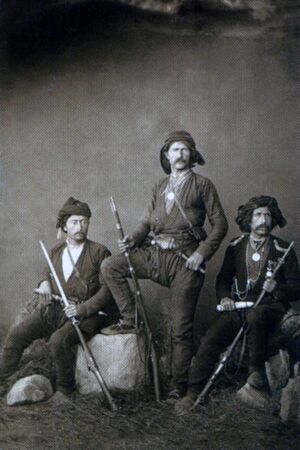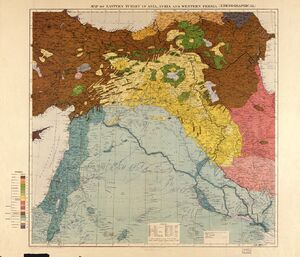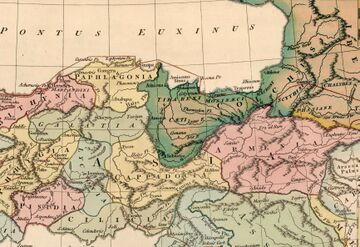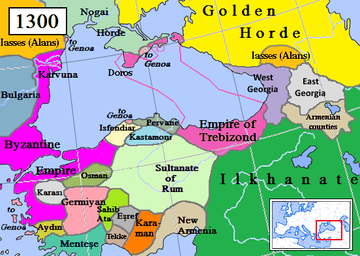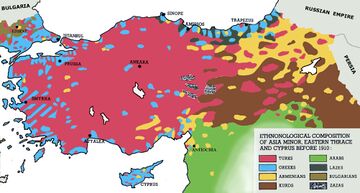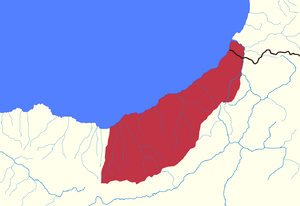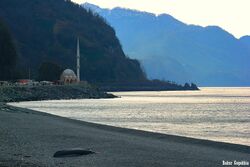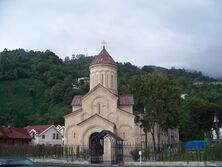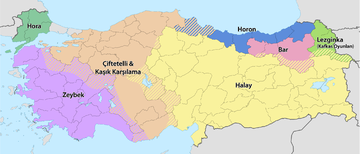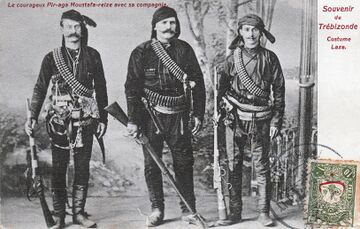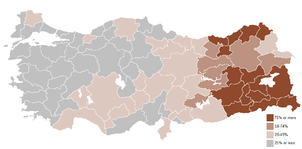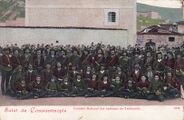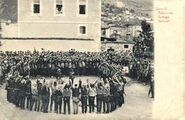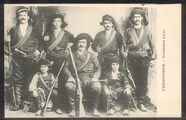لاظ (شعب)
| ||||||||||||||||||||||||
| ||||||||||||||||||||||||
شعب اللاظ أو لاز Laz ، أو لاظي (قالب:Lang-lzz Lazi؛ بالجورجية: ლაზი, lazi؛ أو ჭანი, ch'ani؛ تركية: Laz)، هم جماعة عرقية أصلية تعيش أساساً في المناطق الساحلية على البحر الأسود في تركيا وجورجيا. وتكلمون تقليدياً لغة اللاظ التي هي احدى اللغات الكارتڤلية ولكنها شهدت انتقال لغوي سريع إلى التركية. من 103,900 شخص من عرق اللاظ في تركيا، فقط نحو 20,000 يتكلمون اللاظ وتُصنف اللغة بأنها مهددة (6b) في تركيا وانتقالية (7) في جورجيا على مقياس موسع متدرج لانقطاع الأجيال.[1]
تتفاوت تقديرات إجمالي عدد سكان اللاظ اليوم بشكل كبير، حيث تتراوح أعدادهم ما بين 150.000 إلى مليون شخص، يعيش غالبيتهم في شمال شرق تركيا. يتكلم اللاظ لغة اللاظ، التي تنتمي إلى عائلة اللغات الكارتڤلية، مثل الجورجية وسڤان والمنگرلية.[5][6] تـُصنـَّف لغة اللاظ، من قِبل اليونسكو، بأنها مهددة بالانقراض، حيث يقدر عدد المتحدثين بها في عام 2001 بحوالي 130.000 إلى 150.000 شخص.[7]
أصل الاسم
The ancestors of the Laz people are cited by many classical authors from Scylax to Procopius and Agathias, but the Laz (باليونانية: Λαζοί) themselves are cited by Pliny around the 2nd century BC,[8][9] The ethnonym "Laz" is linked[ممن؟] to a Svan toponym Lazan (i.e. the territorial prefix la- + Zan, "land of the Zan"). The Pontic Lazi, which were incorporated within the Byzantine Empire, and differed from the Caucasian Lazi, or Megrelians, have retained the old name "Lazi" till today.
التاريخ
الأصول
Modern theories suggest that the Colchian tribes are direct ancestors of the Laz-Mingrelians,[10] they constituted the dominant ethnic and cultural presence in the south-eastern Black Sea region in antiquity, and hence played a significant role in the ethnogenesis of the modern Georgians.[11][12]
القِدم
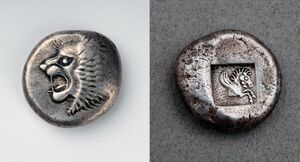
In the thirteenth century BC, the Kingdom of Colchis was formed as a result of the increasing consolidation of the tribes inhabiting the region, which covered modern western Georgia and Turkey's north-eastern provinces of Trabzon, Rize and Artvin.[13] Colchis was an important region in Black Sea trade – rich with gold, wax, hemp, and honey. In the eighth century, several Greek trading colonies were established along the shores of the Black Sea, one of them being Trebizond (باليونانية: Τραπεζοῦς) founded by Milesian traders from Sinope in 756 BC. Trebizond's trade partners included the Proto-Laz tribes of Mossynoeci.
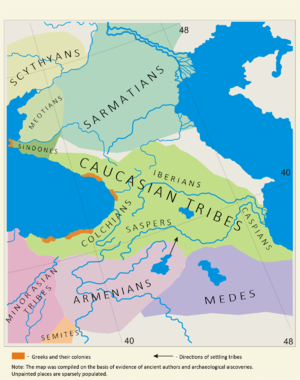
By the sixth century BC, the tribes living in the southern Colchis (Macrones, Mossynoeci, Marres etc.) were incorporated into the nineteenth satrapy of Persia. The Achaemenid Empire was defeated by Alexander the Great, however following the Alexander's death a number of separate kingdoms were established in Anatolia, including Pontus, in the corner of the southern Black Sea, ruled by the Persian nobleman Mithridates I. Culturally, the kingdom was Hellenized,[14] with Greek as the official language.[15] Mithridates VI conquered the Colchis, and gave it to his son Mithridates of Colchis.
As a result of the brilliant Roman campaigns between 88-63 BC, led by the generals Pompey and Lucullus, the kingdom of Pontus was completely destroyed by the Romans and all its territory, including Colchis, was incorporated into the Roman Empire. The former southern provinces of Colchis were reorganized into the Roman province of Pontus Polemoniacus, while the northern Cholchis became the Roman province of Lazicum. Roman control remained likewise only nominal over the tribes of the interior.[16]
The first-century historians Memnon and Strabo remark in passing that the people formerly called Macrones bore in his day the name of Sanni, a claim supported also by Stephanus of Byzantium. The second-century historian Arrian notes that Tzanni, same as the Sanni[17] are neighbours of the Colchians, while the latter were now referred to as the Lazi. By the mid-third century, the Lazi tribe came to dominate most of Colchis, establishing the kingdom of Lazica.
العصور الوسطى
The warlike tribes of the Chaldia, called Tzanni, the ancestors of modern Laz people lived in Tzanica, the area located between the Byzantine and the Lazica. It included several settlements named: Athenae, Archabis and Apsarus; Tzanni were neither subjects of the Romans nor of the king of the Lazica, except that during the reign of the Byzantine emperor Justinian I (r. 527–565) they were subdued, Christianized and brought to central rule.[18][19] The bishops of the Lazica appointed their priests, seeing they are Christians. Tzanni began to have closer contact with the Greeks and acquired various Hellenic cultural traits, including in some cases the language.

From 542 to 562, Lazica was a scene of the protracted rivalry between the Eastern Roman and Sassanid empires, culminating in the Lazic War, where 1,000 Tzanni auxiliaries under Dagisthaeus participated. Emperor Heraclius's offensive in 628 AD brought victory over the Persians and ensured Roman predominance in Lazica until the invasion and conquest of the Caucasus by the Arabs in the second half of the seventh century. As the result of Muslim invasions, the ancient metropolis, Phasis, was lost and Trebizond became the new Metropolitan bishop of Lazica, since then the name Lazi appears the general Greek name for Tzanni. According to Geography of Anania Shirakatsi of the 7th century,[20] Colchis (Yeger in Armenian sources, same as Lazica) was subdivided into four small districts, one of them being Tzanica, that is Chaldia, and mentions Athinae, Rhizus and Trebizond among its cities. From the second half of the eight century the Trebizond area is referred to in Greek sources (namely of Epiphanius of Constantinople) as Lazica. The 10th-century Arab geographer Abul Feda regards city of Trebizond as being largely a Lazian port.
In 780, kingdom of Abkhazia incorporated the former territories of Lazica via a dynastic succession, thus ousting the Pontic Lazs (formerly known as Tzanni) from western Georgia; thereafter, the Tzanni lived under nominal Byzantine suzerainty in the theme of Chaldia, with its capital at Trebizond, governed by the native semi-autonomous rulers, like the Gabras family,[21] of possibly "Greco-Laz" or simply Chaldian origin.[22]
With the Georgian intervention in Chaldia and collapse of Byzantine Empire in 1204, Empire of Trebizond was established along the southeastern coast of the Black Sea, populated by a large Kartvelian-speaking population.[23] In the eastern part of the same empire, an autonomous coastal theme of Greater Lazia was established.[24] Byzantine authors, such as Pachymeres, and to some extent Trapezuntines such as Lazaropoulos and Bessarion, regarded the Trapezuntian Empire as being no more than a Lazian border state.[25] Though Greek in higher culture, the rural areas of Trebizond empire appear to have been predominantly Laz in ethnic composition.[26] Laz family names, with Hellenized terminations, are noticeable in the records of the mediaeval empire of Trebizond, and it is perhaps not too venturesome to suggest that the antagonism between the "town-party" and the "country-party," which existed in the politics of "the Empire," was in fact a national antagonism of Laz against Greek.[27]
In 1282, kingdom of Imereti besieged Trebizond, however after the failed attempt to take the city, the Georgians occupied several provinces,[28] and all the Trebizontine province of Lazia threw off its allegiance to the king of the 'Iberian' and 'Lazian' tribes and united itself with the Georgian Kingdom of Imereti.
العصر الحديث المبكر
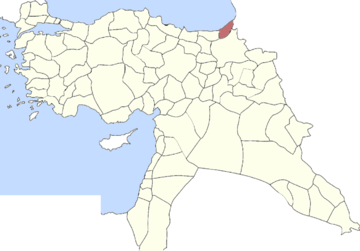
Laz populated area was often contested by different Georgian principalities, however through Battle of Murjakheti in 1535, Principality of Guria ensured control over it, until 1547, when it was finally conquered by resurgent Ottoman forces and reorganized into the Lazistan sanjak as part of eyalet of Trabzon.
The Ottomans fought for three centuries to destroy the Christian-Georgian consciousness of the Laz people.[29] Due to the Ottoman Islamization policy, throughout of seventeenth century Lazs gradually converted to Islam. As the Ottomans consolidated their rule, the Millet system was brought to the newly conquered territories. Local orthodox inhabitants, once subordinated to the Georgian Orthodox Church, had to obey Patriarchate of Constantinople,[30] thus gradually becoming Greeks, the process known as Hellenization of Laz people.[30] Lazs who were under the control of Constantinople, soon lost their language and self-identity as they became Greeks and learned Greek,[31] especially Pontic dialect of Greek language, although native language was preserved by Lazs who had become Muslims. In the middle of the seventeen century, several governors of Tunis, who bore the title of Dey were Laz origin, such as: Muhammad Laz (1647-1653), Mustafa Laz (1653-1665) and Ali Laz (1673).
Not only the Pashas (governors) of Trabzon until the 19th century, but real authority in many of the cazas (districts) of each sanjak by the mid-17th century lay in the hands of relatively independent native Laz derebeys ("valley-lords"), or feudal chiefs who exercised absolute authority in their own districts, carried on petty warfare with each other, did not owe allegiance to a superior and never paid contributions to the sultan. In the period following the war of 1828–1829, Sultan Mahmud II attempted to break the power of the great independent derebeys of Lazistan. In the event, the Laz derebeys, led by Tahir Ağa Tuzcuoğlu of Rize, did rise in revolt in 1832. The revolt was initially successful: at its height in January 1833, but by the spring of 1834, the rising had been put down.[32] The suppression of the rising had finally broken the power of the Laz derebeys. This state of insubordination was not really broken until the assertion of Ottoman authority during the reforms of the Osman Pasha in the 1850s.[32]
In 1547, Ottomans built coastal fortress of Gonia, an important Ottoman outpost in southwestern Georgia,[33][34] which served as capital of Lazistan; then Batum until it was acquired according to the Congress of Berlin by the Russians in 1878, throughout the Russo-Turkish War, thereafter, Rize became the capital of the sanjak. The Muslim Lazs living in newly established Batumi Oblast were subjected to ethnic cleansing; by 1882, approximately 40,000 Lazs had settled in the Ottoman Empire, especially to provinces in Western Anatolia such as Bursa, Yalova, Karamursel, Izmit, Adapazarı and Sapanca.[35] With the spread of Young Turk movement in Lazistan, the short-lived autonomist national movement headed by Faik Efendişi was established. However, it was soon eliminated as the result of Abdul Hamid's intervention.[36]
During the First World War (1914–18) Russians invaded the provinces of Rize and Trabzon. However, following the Bolshevik Revolution in 1917, the Russian forces had to withdraw from the region and finally left the area to the Ottoman-Turkish forces in March 1918. From 1918 to 1920, the national movement swept rapidly all around Lazistan, committees and an interim government was created. It was oriented towards Soviet Russia. But as soon as, the Soviet-Turkish treaty of friendship was concluded, it helped the Turks, to integrate Lazistan.[36] The autonomous Lazistan sanjak existed until 1923, while the designation of the term of Lazistan was officially banned in 1926, by the Kemalists.[37] Lazistan was divided between Rize and Artvin provinces.
At the beginning of the Stalinist era, the Lazs living under Soviet domination had a certain cultural autonomy in the Soviet Union, but after the Second World War, Soviet authorities designed a strategy to clean the border region from so-called unreliable elements. Laz population was sent to exile in Siberia and Central Asia. The political climate had changed after the death of Stalin in 1953, and between 1953 and 1957, all Lazs who had been deported returned to the homeland.
العصر الحديث
Most Laz people today live in Turkey, but the Laz minority group has no official status in Turkey. The number of the Laz speakers is decreasing, and is now limited chiefly to the Rize and Artvin areas.
كيف يُعرِّفون أنفسهم
Over time the Laz living on either side of the frontier have developed different conceptions of what it means to be Laz. Today, most of those living in Turkey do not consider themselves Turkish, but uphold their Laz identity as a separate one.[38] In contrast, Laz identity in Georgia has largely merged with a Georgian identity, and the meaning of "Laz" is seen as merely a regional category.[39] At the same time, in Turkey, the term Laz is a 'folk' definition for people of different ethnic and linguistic backgrounds originating from the Black Sea Region.
التعداد والتوزع الجغرافي
The total population of the Laz today is only estimated, with numbers ranging widely. The majority of Laz live in Turkey, where the national census does not record ethnic data on minor populations.[40]
التجمعات
| البلد / المنطقة | البيانات الرسمية | التقدير | التركز | المقال |
|---|---|---|---|---|
| 500.000[41][42][43] | Rize: Pazar, Ardeşen, and Fındıklı districts.
Artvin: Arhavi and Hopa. minorities in: Çamlıhemşin, Borçka, and İkizdere districts. |
اللاظ في تركيا | ||
| 2,000[1] | Tbilisi Adjara: Sarpi, Kvariati, Gonio, Makho, Batumi and Kobuleti. |
Laz people in Georgia | ||
| 1,000-1,500[44] (Germany 1987) |
Belgium, France and Germany.[45] | Laz people in Germany | ||
| 160[2] | 2,000 | موسكو | اللاظ في روسيا |
المنطقة
The majority of the Laz today live in an area they call Laziǩa, Lazistan, Lazeti or Lazona name of the cultural region traditionally inhabited by the Laz people in modern northeast Turkey and southwest Georgia. Geographically, Lazistan consists of a series of narrow, rugged valleys extending northward from the crest of the Pontic Alps (تركية: Anadolu Dağları), which separate it from the Çoruh Valley, and stretches east–west along the southern shore of the Black Sea. Lazistan is a virtually a forbidden term in Turkey.[A] the name was considered to be an 'unpatriotic' invention of ancien regime.[37]
Laz ancestral lands are not well-defined and there is no official geographic definition for the boundaries of Lazistan. However, the following provinces are usually included:
الاقتصاد
Historically, Lazistan was known for producing hazelnuts.[46] Lazistan also produced zinc, producing over 1,700 tons in 1901.[46] The traditional Laz economy was based on agriculture—carried out with some difficulty in the steep mountain regions and also on the breeding of sheep, goats, and cattle. Orchards were tended and bees were kept, and the food supply was augmented by hunting. The Laz are good sailors and also practise agriculture rice, maize, tobacco and fruit-trees. The only industries were smelting, celebrated since ancient times, and the cutting of timber used for shipbuilding.
الثقافة
Over the past 20 years, there has been an upsurge of cultural activities aiming at revitalizing the Laz language, education and tradition. Kâzım Koyuncu, who in 1998 became the first Laz musician to gain mainstream success, contributed significantly to the identity of the Laz people, especially among their youth.[47]
The Laz Cultural Institute was founded in 1993 and the Laz Culture Association in 2008, and a Laz cultural festival was established in Gemlik.[2][48] The Laz community successfully lobbied Turkey's Education Ministry to offer Laz-language instruction in schools around the Black Sea region. In 2013, the Education Ministry added Laz as a four-year elective course for secondary students, beginning in the fifth grade.[49]
اللغة
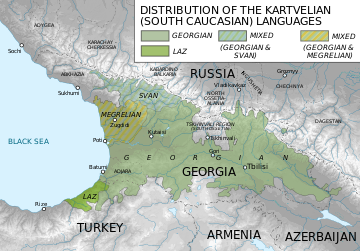
Lazuri is a complex and morphologically rich tongue belonging to the Kartvelian language family whose other members are Mingrelian, Svan and Georgian. N. Marr regarded Laz and Megrelian, two dialects of “linguistically one” language, as two languages. The Laz language does not have a written history, thus Turkish and Georgian serve as the main literary languages for the Laz people. Their folk literature has been transmitted orally and has not been systematically recorded. The first attempts at establishing a distinct Laz cultural identity and creating a literary language based on the Arabic alphabet was made by Faik Efendisi in the 1870s, but he was soon imprisoned by the Ottoman authorities, while most of his works were destroyed. During a relative cultural autonomy granted to the minorities in the 1930s, the written Laz literature—based on the Laz script—emerged in Soviet Georgia, strongly dominated by Soviet ideology. The poet Mustafa Baniṣi spearheaded this short-lived movement, but an official standard form of the tongue was never established.[50] Since then, several attempts have been made to render the pieces of native literature in the Turkish and Georgian alphabets. A few native poets in Turkey such as Raşid Hilmi and Pehlivanoğlu have appeared later in the 20th century.
الدين
Andrew the Apostle after traveling from Trebizond into Lazica in the first century AD, built a church here.[51] The significance of the apostle's activities was that he introduced the principle of Christian faith and thereby paved the way for later missionary activities. The Lazes were converted to Christianity in the 5th century by the first Christian king, Gubazes I of Lazica, who declared Christianity as a state religion of Lazica. After the introduction of Christianity, Phasis was the see of a Greek diocese, one of whose bishops, Cyrus, became a Patriarch of Alexandria between AD 630 and 641.[52][53] Trebizond became the metropolitan see of Lazica when the ancient metropolis, Phasis, was lost by the Byzantine Empire.[54] Trebizond, which was the only diocese established far in the past, Cerasous and Rizaion, both formed as upgraded bishoprics. All three dioceses survived the Ottoman conquest (1461) and generally operated until the 17th century, when the dioceses of Cerasous and Rizaion were abolished. The diocese of Rizaion and the bishopric of Of were abolished at the time due to the Islamisation of the Lazs. Most of them subsequently converted to Sunni Islam.[55][56] There are several ruined churches in present-day Rize and Artvin districts, such as; Jibistasi in Ardeşen, Makriali (Noghedi) in Hopa, Pironity in Arhavi etc.
There are also a few Christian Laz in the Adjara region of Georgia who have reconverted to Christianity.[57]
الأساطير

Famous for its saga and myths and bounded by the Black Sea and the Caucasian Mountains, the ancient region of Colchis spreads out from West Georgia to Northeast Turkey. The famous tale in Greek mythology of the Golden Fleece in which Jason and the Argonauts stole the Golden Fleece from King Aeetes, with the help of his daughter Medea, has brought Colchis into the history books.
العيد
Kolkhoba is an ancient Laz festival. It is held at the end of August or at the beginning of September in Sarpi village, Khelvachauri District. Festival has revived the former lifestyle of Lazeti residents and moments of human relations typical to the times of ancient Greece and Colchis related to the Argonauts journey to Colchis. During the celebration of Kolkhoba theater performances are followed by a variety of activities and it is considered one of the main public festivals.
الموسيقى
The national instruments include guda (bagpipe), kemenche (spike fiddle), zurna (oboe), and doli (drum). In the 1990s and 2000s, the folk-rock musician Kâzım Koyuncu attained to significant popularity in Turkey and toured Georgia. Koyuncu, who died of cancer in 2005, was also an activist for the Laz people and has become a cultural hero.[58]
الرقص
The Laz are noted for their folk dances, called the Horon dance of the Black Sea, originally of pagan worship which was to become a sacred ritual dance. There are many different types of this dance in different regions. Horon is related to those performed by the Ajarians known as Khorumi. These may be solemn and precise, performed by lines of men, with carefully executed footwork, or extremely vigorous with the men dancing erect with hands linked, making short rapid movements with their feet, punctuated by dropping to a crouch. The women's dances are graceful but more swift in movement than those encountered in Georgia. In Greece such dances are still associated with the Pontic Greeks who emigrated from this region after 1922.
الزي التقليدي
The traditional Laz men's costume consists of a peculiar bandanalike kerchief covering the entire head above the eyes, knotted on the side and hanging down to the shoulder and the upper back; a snug-fitting jacket of coarse brown homespun with loose sleeves; and baggy dark brown woolen trousers tucked into slim, knee-high leather boots. The women's costume was similar to the wide-skirted princess gown found throughout Georgia but worn with a similar kerchief to that of the men and with a rich scarf tied around the hips. Laz men crafted excellent homemade rifles and even while at the plow were usually seen bristling with arms: rifle, pistol, powder horn, cartridge belts across the chest, a dagger at the hip, and a coil of rope for trussing captives.
المطبخ
Laz cuisine specialities include:
- Muhlama – a filling corn meal, butter, and cheese fondue;[59]
- Hamsi pilavı – spiced rice enclosed in fried Black Sea anchovies;
- Kuru fasulye – white beans in a tomato sauce;
- Laz böreği – a custard filled baklava like dessert;
- Karadeniz pidesi – an elongated and closed form of the popular pide dish.
التمييز ضدهم
Mustafa Kemal Atatürk, the leader of the early decades of the Republic, aimed to create a nation state (تركية: Ulus) from the Turkish remnants of the Ottoman Empire. During the first three decades of the Republic, efforts to Turkify geographical names were a recurring theme. Imported maps containing references to historical regions such as Armenia, Kurdistan, or Lazistan (the official name of the province of Rize until 1921) were prohibited (as was the case with Der Grosse Weltatlas, a map published in Leipzig).
Cultural assimilation into the Turkish culture has been high, and Laz identity was oppressed during the days of Ottoman and Soviet Rule. One of the pivotal moments was in 1992, when the book Laz History (Lazların tarihi) was published. The authors had failed to have it published in 1964.[47]
أعلام اللاظ
|
|
معرض صور
Amedeo Preziosi: Mustapha, moslem from Batum, painting, ح. 1852
Çürüksulu Ali Pasha with Ottoman Georgian and Laz men. Pasha was a descendant of the Georgian noble family of the Tavdgiridze, 19th century
Young Laz man, engraving from Le Tour du Monde, based on a drawing by Théophile Deyrolle, who traveled in Turkey and Georgia in the 1870s, documenting, among other things, medieval Georgian monuments on the territory of the Ottoman Empire
Soldiers in traditional Trebizond clothing, Constantinople, 1900s
Postcard featuring Laz dancers in national costume in Trabzon
Lazian Militia, ح. 1918
انظر أيضاً
ملاحظات
- ^ "Article 8 of the Anti-Terror Law (Law No. 3713 amended by Law No. 4126) reads, "No one may engage in written and oral propaganda aimed at disrupting the indivisible integrity of the State of the Turkish Republic, country, and nation. [… ] Those who engage in such deeds will be sentenced to from one to three years in prison and given a heavy fine […]". This article means that those who orally or in print make use of words such as Lazistan or Kurdistan risk prosecution."
الهامش
- ^ أ ب ت ث ج "Laz". Ethnologue. Retrieved 4 July 2022. خطأ استشهاد: وسم
<ref>غير صالح؛ الاسم "ethnologue" معرف أكثر من مرة بمحتويات مختلفة. - ^ أ ب ت Национальный состав населения [2010 Census: Ethnic composition of the population] (in الروسية). Russian Federal State Statistics Service. Archived from the original (PDF) on 6 September 2018. Retrieved 31 January 2015.
- ^ Roger Rosen, Jeffrey Jay Foxx, The Georgian Republic, Passport Books (September 1991)
- ^ "ЛАЗЫ СССР И ГРУЗИИ: ПЕРИПЕТИИ ИСТОРИЧЕСКИХ СУДЕБ - Кавказ: новости, история,традиции". www.kavkazoved.info.
- ^ Dalby, A. (2002). Language in Danger; The Loss of Linguistic Diversity and the Threat to Our Future. Columbia University Press. p. 38.
- ^ BRAUND, D., Georgia in antiquity: a history of Colchis and Transcaucasian Iberia 550 BC – AD 562, Oxford University Press, p. 93
- ^ "World Language Atlas". UNESCO. Retrieved 31 January 2015.
- ^ Pliny, NH 6.4.12.
- ^ Braund (1994), p. 157, fn. 24.
- ^ The Kingdom of Colchis Andrew Andersen, George Partskhaladze]
- ^ Miniature Empires: A Historical Dictionary of the Newly Independent States, James Minahan, p. 116
- ^ Cyril Toumanoff, Studies in Christian Caucasian History, p 80
- ^ Andrew Andersen, History of Ancient Caucasus, p. 91
- ^ Children of Achilles: The Greeks in Asia Minor Since the Days of Troy, by John Freely, p. 69–70
- ^ The Foreign Policy of Mithridates VI Eupator, King of Pontus, by B. C. McGing, p. 11
- ^ Talbert 2000, p. 1226.
- ^ Procopius, History of the Wars, I-II [21-25]
- ^ Evans 2000, p. 93.
- ^ Procopius Bell. Pers. i. 15, Bell. Goth. iv. 2, de Aed. iii. 6.
- ^ Ashkharatsuyts, Long Recension, V, 19.
- ^ Hewsen, 47
- ^ A. Bryer and D. Winfield, The Byzantine Monuments and Topography of the Pontos, pp.300
- ^ Mikaberidze, A. (2015). Historical dictionary of Georgia. 2nd ed. Lanham, MD, United States: ROWMAN & LITTLEFIELD, p.634.
- ^ Thys-Şenocak, Lucienne. Ottoman Women Builders. Aldershot, England: Ashgate, 2006.
- ^ Bryer 1967, 179.
- ^ "Laz | Encyclopedia.com". www.encyclopedia.com.
- ^ ROYAL GEOGRAPHICAL SOCIETY (GREAT BRITAIN). (1893). The Geographical journal. London, Royal Geographical Society.
- ^ Miller, Trebizond, p. 30
- ^ HOLY MARTYRS OF LAZETI (17TH–18TH CENTURIES) pravoslavie.ru
- ^ أ ب ქართველთა დენაციონალიზაცია XVII-XX საუკუნეებში; ლაზეთი-თრიალეთი (ქართველთა გაბერძნება) Metropolitan of Manglisi, Ananias Japaridze, nplg.gov.ge
- ^ Марк Юнге, Бернд Бонвеч (2015). Большевистский порядок в Грузии. Moscow: АИРО-XXI. p. 93. ISBN 978-5-91022-306-0.
There are orthodox Lazs who are under the control of the Greek patriarchate in Istanbul. They speak Greek and call themselves Greeks.
- ^ أ ب Abashidze, Aslan; Trikoz, Elena (2009), "The ICC statute and the ratification saga in the states of the Commonwealth of independent states", The Legal Regime of the International Criminal Court, Brill, pp. 1105–1110, doi:, ISBN 9789004163089
- ^ Bagrationi, Vakhushti (1976). Nakashidze, N.T. (ed.). История Царства Грузинского [History of the Kingdom of Georgia] (PDF) (in الروسية). Tbilisi: Metsniereba. pp. 133–135.
- ^ Church, Kenneth (2001). From dynastic principality to imperial district: the incorporation of Guria into the Russian Empire to 1856 (Ph.D.). University of Michigan. pp. 127–129.
- ^ Sarigil, Zeki (2012). "Ethnic Groups at 'Critical Junctures': The Laz vs. Kurds". Middle Eastern Studies. 48 (2): 269–286. doi:10.1080/00263206.2011.652778. hdl:11693/12314. ISSN 0026-3206. S2CID 53584439.
- ^ أ ب "Федорова Е.П. Публичный порядок в российском и французском праве: сравнительная характеристика. Публичный экономический порядок". Актуальные проблемы российского права. 5 (5): 975–981. 2014. doi:10.7256/1994-1471.2014.5.9758. ISSN 1994-1471.
- ^ أ ب Thys-Şenocak, Lucienne. Ottoman Women Builders. Aldershot, England: Ashgate, 2006. Print.
- ^ Dzneladze, Irakli (May 1, 2017). "The Laz: Two Tales of One People | Caucasus' Diversity". chai-khana.org.
- ^ Minorsky, V. "Laz." Encyclopaedia of Islam, Second Edition. Edited by: P. Bearman , Th. Bianquis , C.E . Bosworth , E. van Donzel and W.P. Heinrichs. Brill, 2010.,
- ^ Silvia Kutscher (2008). "The language of the Laz in Turkey: Contact-induced language change or gradual loss?" (PDF). Turkic Languages. 12 (1). Retrieved 31 January 2015.
Due to a lack of census information on minorities (aside from a small number of exceptions such as the Greek or Armenian populations), the actual number of Laz living in Turkey can only be estimated
- ^ Encyclopedia of the Orient
- ^ "ecoi.net". Archived from the original on 2008-07-04. Retrieved 2008-07-18.
- ^ "Nothing found for View 865".
- ^ "Archived copy". Archived from the original on 2016-10-09. Retrieved 2018-04-14.
{{cite web}}: CS1 maint: archived copy as title (link) - ^ خطأ استشهاد: وسم
<ref>غير صحيح؛ لا نص تم توفيره للمراجع المسماةstp - ^ أ ب Prothero, W.G. (1920). Armenia and Kurdistan. London: H.M. Stationery Office. pp. 52, 73.
- ^ أ ب Ismail Güney Yılmaz (7 January 2015). "90'lar: Laz Kültür ve Kimlik Hareketinin Doğuşu" [1990s: The Birth of the Laz Culture and Identity Movement] (in التركية). Lazebura. Retrieved 31 January 2015.
- ^ Kâmil Aksoylu (3 July 2013). "Laz Kültürü Hareketi̇ 93 Süreci̇nden Laz Ensti̇tüsüne" (in التركية). Lazca.org. Retrieved 31 January 2015.
- ^ "Lazuri classes to begin in secondary schools in Turkey". Anadolou. 14 September 2013. Retrieved 31 January 2015.
- ^ Iksander Tsitashi (1939). Литературная энциклопедия (Encyclopedia of Literature) Лазская литература [Laz literature] (in الروسية). Moscow.
{{cite book}}: CS1 maint: location missing publisher (link) - ^ 1973-, Pelkmans, Mathijs Emiel (2003). Uncertain divides : religion, ethnicity, and politics in the Georgian borderlands. s.n.] OCLC 193987206.
{{cite book}}:|last=has numeric name (help)CS1 maint: multiple names: authors list (link) - ^ Bury(1889), p. 458-462
- ^ Holmes(1905), p. 728-730
- ^ Trebizond newadvent.org
- ^ Yakar, Jak (2000). "Ethnoarchaeology of Anatolia: rural socio-economy in the Bronze and Iron Ages". Jak Yakar. Retrieved 26 May 2014.
Formerly Christians, they converted to Sunni Islam a little over four centuries ago.
- ^ Özhan Öztürk. Pontus. Genesis Yayınları. İstanbul, 2009. s. 737-38, 778
- ^ Roger Rosen, Jeffrey Jay Foxx (September 1991) The Georgian Republic, Passport Books, Lincolnwood, IL ISBN 978-0-84429-677-7
- ^ Hake, Sabine; Mennel, Barbara (2012-10-01). Turkish German Cinema in the New Millennium: Sites, Sounds, and Screens. Berghahn Books. ISBN 978-0-85745-769-1.
- ^ Alkan, Sena. "A traditional Black Sea treat: Mıhlama". Daily Sabah, Nov 26, 2016. Retrieved Feb 1, 2020.
ببليوگرافيا
- Andrews, Peter (ed.). 1989. Ethnic Groups in the Republic of Turkey. Wiesbaden: Dr. Ludwig Reichert Verlag, pp. 497–501.
- Benninghaus, Rüdiger. 1989. "The Laz: an example of multiple identification". In: Ethnic Groups in the Republic of Turkey, edited by P. Andrews.
- Bryer, Anthony. 1969. "The last Laz risings and the downfall of the Pontic Derebeys, 1812–1840". In: Bedi Kartlisa 26, pp. 191–210.
- Hewsen, Robert H. "Laz". In: World Culture Encyclopedia. Accessed on September 1, 2007.
- Negele, Jolyon. Turkey: Laz Minority Passive In Face Of Assimilation. Radio Free Europe/Radio Liberty, 25 June 1998.
وصلات خارجية
- Laz Culture Association (Turkish)
- Lazca.org: Culture, News and Information (Turkish)
- Lazebura.com: Culture, News and Information (Turkish)
- Lazuri.com: Culture Portal (Turkish)
خطأ لوا في وحدة:Authority_control على السطر 278: attempt to call field '_showMessage' (a nil value).
- CS1 uses الروسية-language script (ru)
- CS1 الروسية-language sources (ru)
- CS1 التركية-language sources (tr)
- CS1 maint: location missing publisher
- CS1 errors: numeric name
- Short description is different from Wikidata
- Articles using infobox ethnic group with image parameters
- شعب اللاظ
- Articles containing جورجية-language text
- Pages using Lang-xx templates
- Articles containing Greek-language text
- Articles with specifically marked weasel-worded phrases from April 2020
- Articles with hatnote templates targeting a nonexistent page
- جماعات عرقية في جورجيا
- جماعات عرقية في تركيا
- Ancient peoples of Georgia (country)
- Tribes in Greco-Roman historiography
- شعوب القوقاز
